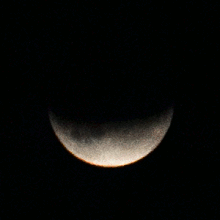
Back Maansverduistering Afrikaans Mondfinsternis ALS Eclix lunar AN خسوف Arabic চন্দ্ৰ গ্ৰহণ Assamese Eclís llunar AST Ay tutulması Azerbaijani آی توتولماسی AZB Ай тотолоу Bashkir Gerhana Bulan BAN
This article needs additional citations for verification. (January 2023) |

A lunar eclipse is an astronomical event that occurs when the Moon moves into the Earth's shadow, causing the Moon to be darkened.[1] Such an alignment occurs during an eclipse season, approximately every six months, during the full moon phase, when the Moon's orbital plane is closest to the plane of the Earth's orbit.
This can occur only when the Sun, Earth, and Moon are exactly or very closely aligned (in syzygy) with Earth between the other two, which can happen only on the night of a full moon when the Moon is near either lunar node. The type and length of a lunar eclipse depend on the Moon's proximity to the lunar node.[2][3]
When the Moon is totally eclipsed by the Earth (a "deep eclipse"),[4][5] it takes on a reddish color that is caused by the planet when it completely blocks direct sunlight from reaching the Moon's surface, as the only light that is reflected from the lunar surface is what has been refracted by the Earth's atmosphere. This light appears reddish due to the Rayleigh scattering of blue light, the same reason sunrises and sunsets are more orange than during the day.
Unlike a solar eclipse, which can only be viewed from a relatively small area of the world, a lunar eclipse may be viewed from anywhere on the night side of Earth. A total lunar eclipse can last up to nearly two hours, while a total solar eclipse lasts only a few minutes at any given place, because the Moon's shadow is smaller. Also, unlike solar eclipses, lunar eclipses are safe to view without any eye protection or special precautions.
The symbol for a lunar eclipse (or indeed, any body in the shadow of another) is ![]() (U+1F776 🝶).
(U+1F776 🝶).
- ^ McClure, Bruce (27 July 2018). "Century's Longest Lunar Eclipse July 27". EarthSky. Retrieved 1 August 2018.
- ^ "Eclipses - NASA Science". science.nasa.gov. Retrieved 13 May 2024.
- ^ "NASA - Periodicity of Lunar Eclipses". eclipse.gsfc.nasa.gov. Retrieved 13 May 2024.
- ^ Staff (2023). "PHYS 1350 Astronomy Exam 3 (TXST-Olson)". Quizlet. Archived from the original on 9 November 2023. Retrieved 9 November 2023. "What is a deep eclipse? The smaller star is behind the bigger star"
- ^ Miller, A.M.; et al. (7 November 2023). "ATel #16328 - ASASSN-23ht: A Deep Eclipse Event". The Astronomer's Telegram. Archived from the original on 9 November 2023. Retrieved 9 November 2023.
© MMXXIII Rich X Search. We shall prevail. All rights reserved. Rich X Search